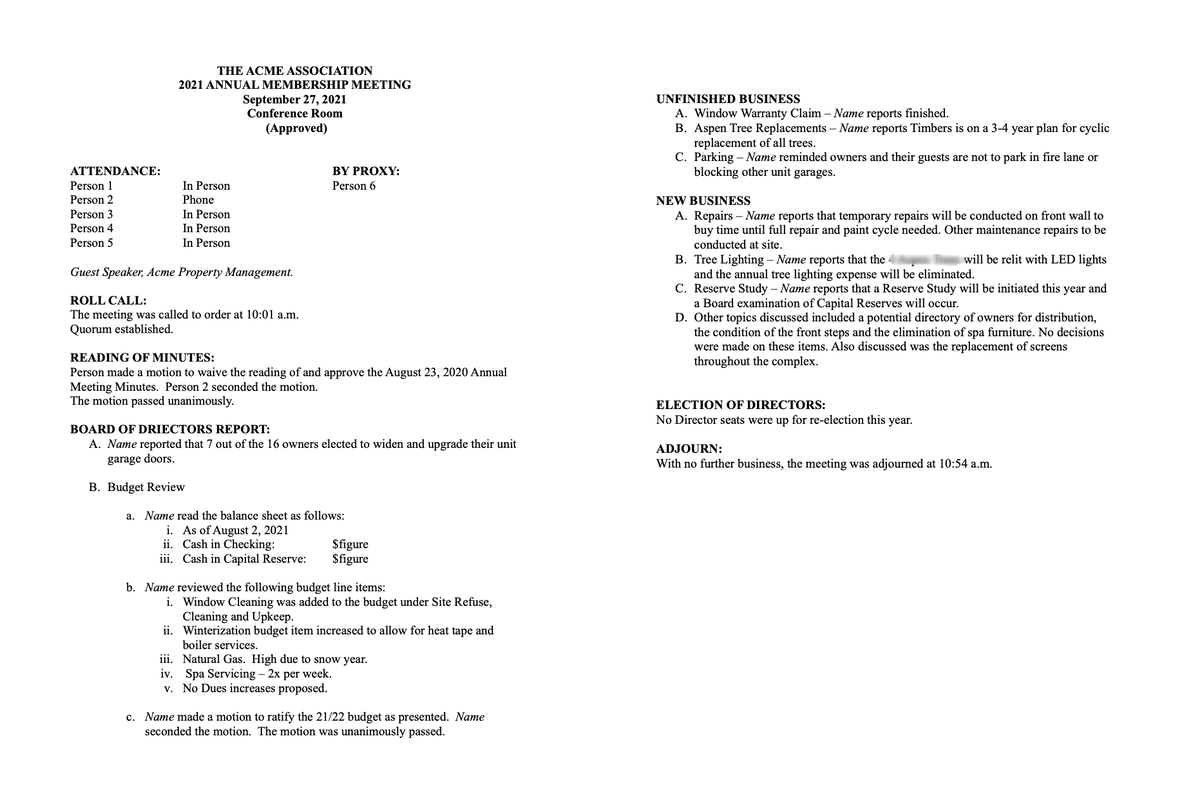

Have you been tasked with recording your HOA’s meeting minutes? Wondering how meeting minutes should look like, and if there’s a template you could use?
Yes, it’s the law - HOA boards must take minutes of practically every meeting, even the executive session. That seems only fair, of course, since associations should have an official record of everything that’s been discussed during a meeting.
But it doesn’t mean that recording those minutes for the first time isn’t a daunting task. Quite the contrary. That’s especially true if you have never even seen a meeting minutes template before.
Well, good news - You’ll find how to do it from this guide. Below, you’ll find everything you need to know about recording HOA meeting minutes. What’s more, we’ll also show you a sample of a minutes document to use as a template for your meetings.
But let’s start at the beginning.
Let’s start at the beginning - What are the HOA meeting minutes?
Well, for a HOA, the meeting minutes are a record of everything that’s happened between members during the meeting.
Minutes include information about what was discussed during a meeting, what actions were taken, what decisions were made, and so on.
But why are meeting minutes so important?
As we’ve already discussed, the law requires every HOA to record meeting minutes. But why? What makes them so important?
You see - Meeting minutes serve as a great reference for anything that’s happened during various meetings.
As a result, the minute’s document is often the first port of call when there’s uncertainty over whether certain issues have been discussed, resolved, or even brought forward.
Being an official record, minutes also often help resolve disputes between board members.
For that, and many other reasons, meeting minutes are also a public record. All residents have the right to review board meeting minutes. However, this rule does not apply to executive meeting minutes, of course. The session covers mostly confidential matters, after all.
What’s more, minutes must be made available to all residents to see within a specific time frame. Now, the time by which you must distribute those meetings to other board members, and made them available publicly differs from state to state. You can find that information in your State law.
Typically, the task falls to the board secretary. In some cases, it can also be the assistant secretary. The person will also sign the minutes once they’re ready.
However, in some HOAs, the board might also want to approve the minutes and sign off the document.
One of the biggest problems for anyone tasked with taking down meeting minutes for the first time is realizing what to include (and what to omit.)
So, let’s start with that. Here are the meeting elements you should include in the minutes’ document:
#1. Basic information about the meeting
Meeting minutes must include information about the meeting, such as:
Also, it’s not required but always a good practice to record when the HOA president called the meeting to order. This might be the same time as the scheduled start time. However, sometimes with board members being late for various reasons, meetings get slightly delayed, which should also be reflected in the meeting minutes.
#2. Attendance
Next, list present and absent members, along with their positions on the board.
#3. Guest speakers
If there are any guest speakers - representative of an HOA management company or a resident that would like to discuss a particular issue - record them in the meeting minutes as well.
#4. Presented reports
Most HOA meetings will include the presentation of reports by different board members and committees. For example, attendees might hear the HOA manager’s report detailing the progress with CC&R enforcement, finance committees report, and so on.
Now, you don’t have to record the actual report, of course. However, the minutes’ document should include a list of reports presented and by whom.
#5. Motions, votes, and discussions
Finally, the document should also list all the motions discussed during the meeting, votes carried out, and other discussions.
Now, let’s look at the don’ts of recording HOA meeting minutes. The following meeting elements do not have to (and even shouldn’t be) included in the document:
#1. Irrelevant discussions
At times, board members might get into a discussion between themselves. Now, the discussion happens during the meeting, and so, it seems like it should be recorded. But that’s not the case.
Unless the discussion is relevant to a particular issue on the agenda, it should not be recorded in the minutes.
#2. Personal opinions
Similarly, any personal views or opinions by board members should be omitted from the official record.
#3. Arguments
Finally, and, probably, quite understandably, any arguments or disputes between members occurring during the meeting have no place in the meeting minutes.
Let’s bring it all together and see how the HOA meeting minutes document should look like.

For the end, let us offer you a handful of tips to make the process of recording meeting minutes easier and ensure that the document meets everyone’s expectations.
Tip 1. Use impartial tone
Meeting minutes should only include facts. To ensure that, write minutes in an impartial tone. Do not include any opinions, whether yours or someone else’s. Do not record anything that couldn’t be verified as a fact either.
Tip 2. Keep styling to a minimum
When preparing the final meetings document, you can be tempted to highlight certain information. For example, you may want to style some elements with bold or use underline to emphasize words or phrases.
Well, you shouldn’t. The minute’s document should be impartial and only present a record of a meeting, not its analysis. Because of that, you should not style the copy in any way beyond using the format we’ve shown above.
That said, there is one styling technique you could use:
Tip 3. Use lists
Lists - bulleted or numbered - will make the document easier to skim over, read, and quickly find relevant information. But unlike setting text in bold or underlining it, lists do not highlight or emphasize anything in the copy. Instead, they only help to organize the content more easily. And that’s why they’re fine to use.
Now you know how HOA meeting minutes look like, what to include (and what to omit,) and have a template that you could use to record minutes of your association’s next meeting.
HOALife is the first and only HOA management software dedicated solely to assisting boards and managers with inspections and CC&R enforcement. From streamlining the process of violations inspections, sending notices, tracking progress to reporting, HOALife makes violations enforcement easy.
What’s more, HOALife also lets you inspect Assets - Common area elements within an association, such as playgrounds, parks, swimming pools, clubhouses, and entry monuments - and quickly act on any issues you may have found.